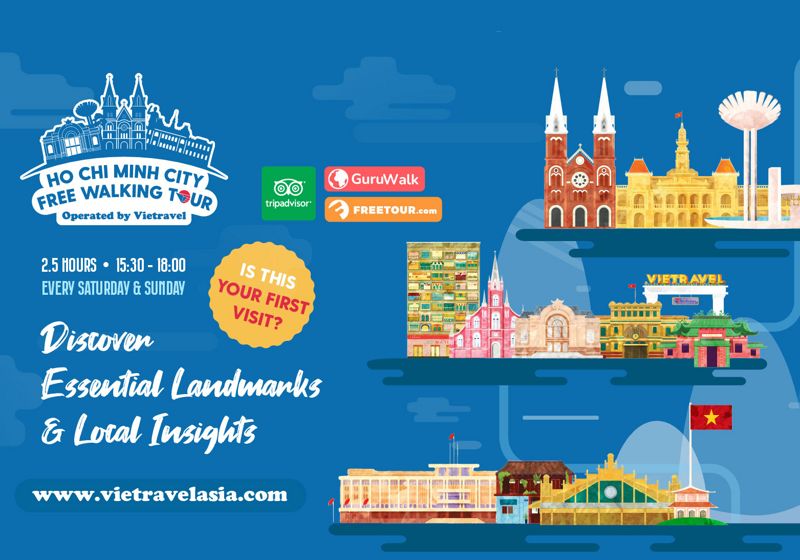
Located in the lively center of Ho Chi Minh City, Independence Palace serves as a moving reminder of Vietnam's lengthy past. It invites you to explore the country's past among the noise of motorbikes and the shadow of skyscrapers. Vietravel, Vietnam's Largest Aviation and Tourism Corporation, shows you a perfect Independence Palace travel guide to uncover the secrets of this must-visit landmark.
Learn more about Ho Chi Minh City Travel Guide.
I. Where is Independence Palace?
Located in the heart of District 1, this legendary place (also known as Reunification Palace) occupies a prime spot in the city center. It’s a prominent destination, easily accessible and well-connected by various modes of transport.
Former name: Norodom Palace (before 1954)
Address: 135 Nam Ky Khoi Nghia Street, Ben Thanh, District 1 (Reunification Palace on Google Maps)
Open time: 8:00 AM - 3:30 PM daily.
Phone number: 028 3822 3652

II. The best time to visit in a day
1. Morning for photography lover:
From 8 to 10 in the morning, magic happens. The place is quiet and cool, perfect for exploring. Dive into the old stories told by the displays. Wander through the pretty gardens without breaking a sweat. The soft morning light makes everything look extra special. It's like the whole place is posing for your camera! Grab this chance to snap some amazing photos that'll make your friends say "Wow!"
Tip: Arrive early to avoid the mid-morning tourist rush and enjoy a more relaxed experience.
2. Afternoon for history enthusiasts:
As the clock strikes 2, the place buzzes with life. Tourists and locals flood in, filling the streets with energy. But watch out - the sun's rays are fierce and can hurt your skin. Now's the perfect time to step inside the Reunification Palace. Cool off and uncover the amazing stories hidden within its walls. You'll feel like you're walking through time itself!
Tip: Reunification Palace ticket sales end at 3:30 pm and the palace shuts at 4:30 pm, so plan your visit accordingly to make the most of your time.
Discover the ideal time to visit Ho Chi Minh City.
III. The history – Independence Palace travel guide
The Reunification Palace, originally known as “Norodom Palace”, was constructed in 1868 as a residence for the French Governor-General of Indochina. The building was designed in a neo-Baroque style by famous Parisian architect Achille-Antoine Hermitte, who also created the original Hong Kong City Hall and the Sacred Heart Cathedral in Guangzhou. It's said that Hermitte aimed to create a monument to honor the world's finest cities. The grand palace reportedly cost over four million Francs, more than a quarter of the colony's public works budget.


After the departure of the French in 1954, it became the home of the South Vietnamese President, Ngo Dinh Diem, and was renamed Independence Palace.
In 1962, after a bombing that heavily damaged the structure, Mr.Diem commissioned the construction of a new palace. Renowned architect Ngo Viet Thu designed the current building, which was completed in 1966. The new palace’s design transformed from European to modernist architectural styles. The new design is characterized by clean lines, open spaces, and a blend of modern and Vietnamese traditional aesthetics, making it distinct from the original colonial design of the Norodom Palace.
- Reunification Palace - Ho Chi Minh City's Living Legend
The palace saw history unfold when the Vietnam War ended right at its doorstep. On April 30, 1975, a North Vietnamese tank smashed through its gates, changing everything. Saigon fell, and Vietnam became one country again. The South's president, who had only been in charge for two days, gave up without a fight. He went on the radio and told everyone, "The Saigon government is finished, top to bottom." Just like that, an era ended and a new one began.
The fall of Saigon marked the end of the Vietnam War and the beginning of the reunification of Vietnam under communist control. The Reunification Palace, once a symbol of the South Vietnamese government, became a symbol of the country's reunification. It was later renamed the Reunification Palace to reflect this pivotal moment in history.

Discover more about Ho Chi Minh City - Turtle Lake Travel Guide.
IV. Architectural wonders
The original building was constructed in the 1860s during the French colonial period in Vietnam. Its architecture was heavily influenced by classical European styles, showcasing the intricate and grand details characteristic of colonial architecture. Designed by architect Hermite, the palace was completed in 1873.

Norodom Palace - initial construction - featured a majestic structure with spacious rooms, high vaulted ceilings, and large columns that embodied French architectural elegance. The palace grounds were adorned with sculptures and gardens, creating a luxurious and imposing atmosphere. After reconstruction, the architecture of the new Reunification Palace features clean lines, open spaces, and an abundance of natural light. The design includes large windows, wide balconies, and functional meeting rooms. Ngo Viet Thu skillfully integrated traditional motifs, such as intricate decorative patterns and open, harmonious spaces that blend with the surrounding nature.
The layout of the palace, from the overall plan to the individual building layout, is deeply rooted in Eastern philosophy, symbolized through Chinese characters to convey good wishes for the Vietnamese people. The entire floor plan forms the character "Cát" (吉), meaning good fortune and luck. The central area shapes the character "Khẩu" (口), emphasizing education and freedom of speech. The central flagpole within the "Khẩu" character resembles a vertical stroke, creating the character "Trung" (中), reminding of loyalty and faithfulness. Three horizontal strokes are formed by the surrounding verandas, the honorable balcony, and the entrance veranda, creating the character "Tam" (三), symbolizing humanity, intelligence, and martial virtue. Connecting the three horizontal strokes with a vertical line forms the character "Vương" (王), combined with the flag tower above as a dot, creating the character "Chủ" (主), representing national sovereignty. The front facade of the palace, with the entire second and third-floor balconies combined with the entrance veranda and two wooden-clad columns, forms the character "Hưng" (興), symbolizing prosperity.

The Reunification Palace is a masterpiece of 1960s architecture, blending modernist design with traditional Vietnamese elements. The palace features a central hall with an impressive dome, five levels of rooms and halls, and lush gardens. Each room, from the Presidential Reception Room to the basement war rooms, offers a glimpse into the political and social history of Vietnam.
V. What to do at Independence Palace
1. Walk and explore every corners
Over 100 rooms, each with its own job, spread throughout the palace. From big party halls to quiet offices, every space tells a story. You can walk through the many rooms and chambers, each preserved as it was during the height of the Vietnam War. Follow the travel map of Independence Palace below for easy navigation:

Also, imagine the Independence Palace as a multi-layered wonder. It's split into three main parts: a secret basement, a bustling ground floor, and four floors reaching to the sky. Each level has its own special purpose, like chapters in a book. Follow Independence Palace travel guide to uncover the palace's secrets from bottom to top!

Here are some must-see rooms we recommend:
1. The Command Center
Located in the basement, the Command Center is one of the most intriguing and historically rich parts of the palace. This room served as the strategic hub for military operations during the Vietnam War. It is filled with communication equipment, maps, and planning tools, creating a stark and utilitarian atmosphere. Visitors can see the original devices and documents used to coordinate and execute military strategies, offering a direct connection to the intense wartime activities.

2. The Cabinet Room
On the first floor, the Cabinet Room, where the president and his cabinet convened, is another key highlight. This spacious room features a long, polished wooden table surrounded by chairs, where major policy discussions and strategic planning took place. The room is equipped with maps and documents from the era, giving visitors a sense of the intense and significant deliberations that occurred within these walls.Where to go in Ho Chi Minh City?

3. The State Banqueting Hall - Independence Palace travel guide
Also step into the Banquet Hall on the first floor is an opulent space used for official receptions, state dinners, and other formal gatherings. It is beautifully decorated with chandeliers, long dining tables, and ornate chairs, showcasing both modern and traditional Vietnamese design elements. This hall hosted many dignitaries and leaders, serving as a venue for important diplomatic and social events. The preserved settings provide a glimpse into the grandeur and elegance of such occasions.

4. The Presidential Office
On the second floor, the Presidential Office is a room of immense historical significance, preserved to reflect its appearance during the Vietnam War. This room is adorned with period furniture, including a stately wooden desk and elegant chairs. The walls are lined with bookshelves and decorated with portraits and historical artifacts. It was in this office that the president conducted important meetings, made critical decisions, and managed the affairs of the nation during a tumultuous period.

5. The Private Apartment
Walk down the second floor's main hallway and you'll find the Private Apartment. This is where he and his family actually lived. These rooms include bedrooms, a living room, and a private dining area, all furnished with period-appropriate décor. Unlike the formal and official rooms, these quarters have a more personal and intimate feel, reflecting the everyday life and private moments of the presidential family during the war.

6. The rooftop helipad
Climb up to the very top and you're in for a treat! The roof isn't just any old roof - it's got a special flat area for helicopters to land. Stand here and you can see the whole city spread out around you like a giant map. It's the best view in town!

7. The garden with lush trees and a fresh grass field
The palace is wrapped in a green hug of gorgeous gardens. Take a slow stroll and let your eyes wander. You'll spot fun sculptures peeking out from bushes and hear the gentle splash of fountains. It's like a little piece of paradise right in the middle of the busy city. Find a quiet corner and sit for a while. Listen to the birds, smell the flowers, and feel your worries melt away. It's hard to believe that just beyond these peaceful gardens, the city is rushing and roaring.

2. Enjoy Saigon-styled meals at The Cafe 30/4 - What to do in Ho Chi Minh City
Next, footsore and mind-dazzled from the Independence Palace's architectural wonders? Fear not, weary traveler! Salvation awaits mere steps away at Cafe 30/4.
Nestled within the palace grounds like a hidden gem, this café isn't your run-of-the-mill pit stop. It's a slice of Vietnamese garden paradise. Lush greenery surrounds you, whispering secrets of coolness and calm. The air? Fresher than a morning lotus. The vibe? More chill than a mountain stream. When the sun hits high noon and your stomach growls louder than a Saigon motorbike, Cafe 30/4 has your back. Southern flavors dance across the menu, promising a culinary journey to rival your palace adventure.

VI. How to get around Indpendence Palace in Ho Chi Minh City? - Independence Palace travel guide
1. Electric Car (around 10 minutes)
Hop into a cool electric car right at the palace entrance. These quiet, earth-friendly cars are like time machines on wheels! Sit back and relax as you zoom through the huge palace grounds - it's as big as 24 football fields! Don't worry about getting lost or missing anything important. The car talks to you, pointing out cool spots and sharing exciting stories about the palace. In just 10 minutes, you'll see it all and learn tons. It's like a history lesson and a theme park ride rolled into one!Free navigationWander freely and discover its secrets at your own speed. Look out for shiny new signs and info panels - they're like friendly helpers scattered throughout the building. Each room has a clear nameplate telling you what happened there. It's like a giant history puzzle, and you get to put the pieces together. Follow your curiosity and let the palace reveal its stories to you!

2. Guided Tours
Want a personal touch? Stop by the Information Desk and ask for a guide. These friendly experts know all the palace secrets and can't wait to share them. For a small fee, they'll take you on an adventure through history. Join a group - up to 25 grown-ups or 50 kids can explore together. Your guide will bring the palace to life with stories and facts you won't find anywhere else. It's like having a time-traveling friend show you around!

3. Automatic Audio Guides
Since 2017, the palace has offered a cool way to learn: talking headsets! Put one on and listen to the palace's secrets in your own language. You can choose from 10 different languages, including English, French, Japanese, Chinese, Korean, German, Spanish, Russian, Thai, and Vietnamese. It's like having a friendly expert whispering in your ear as you walk around. No matter where you're from, you can dive deep into the palace's amazing story. These headsets make sure everyone gets to enjoy the full experience - it's history that speaks your language!

After your palace adventure, settle in for a movie treat! Cozy up in a nice screening room to watch "History of Independence Palace." This 30-minute film brings the palace's story to life. You can pick from four languages: English, French, Japanese, or Chinese. It's like having a time machine – you'll see the palace's past unfold before your eyes. This fun film wraps up your visit with a burst of excitement and new facts. Don't miss it!
VII. How to get to Independence Palace?
Want to get to Independence Palace easily? Vietravel has picked the best ways to go. We'll help you find a way that fits your style and budget. Let's make your trip fun with our local tips!
1. By Bus
Want to travel like a local? Take a bus! You'll see daily life in Saigon as you ride. Buses 05, 14, 152, 20, 28, 30, 31, or 36 all go to Independence Palace.

Tip: Try the Hop-on-Hop-off bus if you want to stop at other places too!
2. By Taxi
Need a quick ride? Get a taxi or use a ride app. You can use Mai Linh, Vina Sun, Grab, Be, Xanh SM, or GoJek! With apps, you'll know the price before you ride.

3. By Walking
Like to explore? Try walking! You'll feel the city's buzz and see cool sights. But watch out for hot sun and rain. New to the city? A guide can show you hidden spots.
4. By Cyclo
Want an old-school ride? Try a cyclo – it's like a big bike with a seat. It costs more, but it's a special way to see the city. You can take photos as you ride to Independence Palace.
Each way to get to Independence Palace shows you something different about the city. Which one do you like? The city is waiting for you!

VIII. Conclusion
Dive into history with Vietravel's Independence Palace travel guide. But that's just the start of your Ho Chi Minh City adventure. Where to go in Ho Chi Minh City? The city is packed with must-see spots! Check out the lively Ben Thanh Market for local flavors and souvenirs. Or find peace at the beautiful Notre Dame Cathedral Basilica. Want to really get to know the city? Join Vietravel's Walking Tour. Our local guides know all the cool stories and secret places most tourists miss. They'll help you see the real Ho Chi Minh City, beyond the usual tourist spots.
Ready to explore more? Dive into the Ho Chi Minh City travel guide for a detailed itinerary, tips, and recommendations to ensure a memorable trip. Let Vietravel help you discover the vibrant and historical heart of Vietnam.
As the Largest Aviation - Tourism corporation in the country, Vietravel consistently provides high-standard services at the most competitive prices so that you can discover the beauty of not only Vietnam but all of Southeast Asia.
Please contact us for more information.
Vietravel – Asia’s Leading Tour Operator
Hotline: (84) 35 235 61 61
Email: [email protected]
Website: www.vietravelasia.com
#VietravelAsia #Vietravel #Vietnam #Hochiminhcity #Reunificationpalace #Independencepalace #discovery #attraction #travelguide #WheretogoinHoChiMinhCity? #WhattodoinHoChiMinhCity


